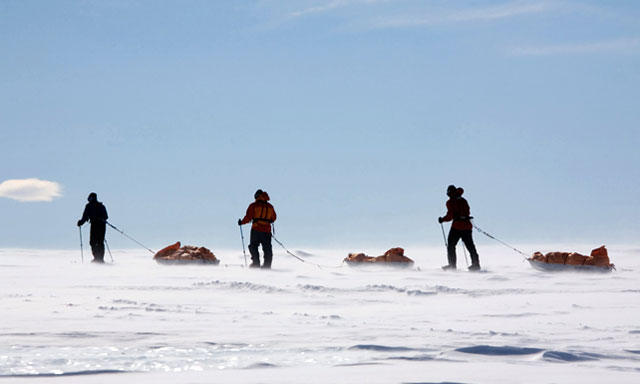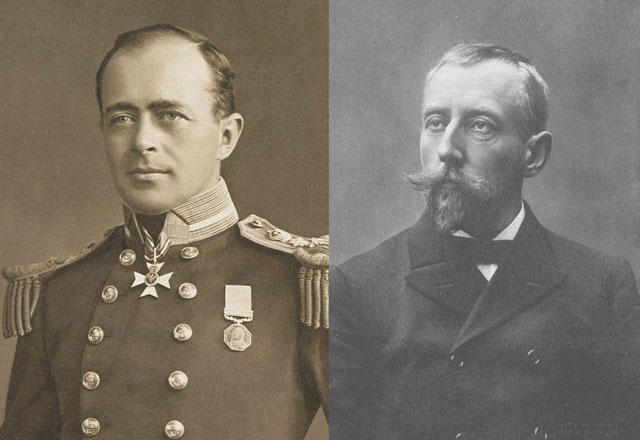Centennial celebrationSouth Pole prepares for 100-year anniversary of historic race between Amundsen and ScottPosted November 18, 2011
A century ago, perhaps the last great feat of terrestrial exploration took place in one of the world’s most inhospitable locations, spawning a race between two very different men. On one side was Norwegian Roald Amundsen, a veteran polar explorer who had honed his skills among the Inuit of the Arctic. In opposition was Capt. Robert Falcon Scott, the epitome of the stoic British military officer. Their goal: To be the first to stand at the geographic South Pole. The story is well known: Amundsen and his team easily reached the bottom of the world first on Dec. 14. Scott and his men followed more than a month later, on Jan. 17, perishing on the return trip only 11 miles from their resupply depot. Now, 100 years later, adventurers, history buffs and avid travelers are expected to visit this once most inaccessible of sites on Antarctica’s polar plateau to commemorate the achievement. Today, 90 South is home to the Amundsen-Scott South Pole Station 
Photo Credit: Dwight Bohnet/Antarctic Photo Library
The South Pole Station is named after Amundsen and Scott.
At the height of the summer field season — November to February — the station houses about 250 support personnel and scientists. This year, the National Science Foundation (NSF) Up to 150 people alone are expected to be at the station on Dec. 14, including a diplomatic party of about a dozen people from Norway led by Norwegian Prime Minister Jens Stoltenberg “In terms of an event, the centennial is completely new territory,” said Bill Coughran, South Pole area director for Raytheon Polar Services (RPSC) For the anniversary year, station personnel will set up a temporary visitor center and small retail store not far from the ceremonial pole behind the station, to be powered by a solar array. In addition, the tour operators will set up a small base camp at the end of the station’s airfield skiway, with additional facilities to accommodate the larger number of tourists expected around the anniversary dates. “You don’t just pop in to South Pole with these kind of numbers for the day,” Coughran said. Tourist visits at the South Pole have been creeping up over the last decade. As recently as the 2003-04 season, the station saw 40 visitors. Five years later, the number had quadrupled. Last year, according to statistics from the International Association of Antarctica Tour Operators (IAATO) IAATO lists three operators as members for land-based expeditions: Antarctic Logistics & Expeditions (ALE)/Adventure Network International (ANI)
Most visitors to Antarctica arrive by sea, from small, private yachts to luxury cruise ships. IAATO operators reported supporting 33,824 tourists in 2010-11. “Overall, land-based tourism — including to the South Pole — is a very small fraction of the visitor numbers to the continent on an annual basis,” noted Steve Wellmeier, executive director of IAATO. However, Antarctic tourism has been in decline in recent years after peaking at 46,265 visitors in 2007-08. The global recession has largely been to blame, though the numbers are expected to plummet even further this year with a ban on the use of heavy fuel oil imposed by the International Maritime Organization in the Southern Ocean taking effect. IAATO is projecting a 25 percent decline in visitors for 2011-12. South Pole tourism will certainly buck that trend — at least this year. And it’s not a cheap visit. For example, ALE charges $40,500 for flights to the South Pole. More adventurous tourists opt to ski to the South Pole, commonly from Hercules Inlet on the Antarctic coast, about a two-month journey of more than 700 miles. Others find more unusual means to reach the bottom of the world, such as last year’s expedition organized by the Kazakhstan National Geographic Society and TAC. The expedition team drove two Arctic Truck AT44s across 1,400 miles to the South Pole in a record-breaking 108 hours. This year’s roster of expeditions is a long one, from an adventurer from Oman who hopes to become the first Arab to walk to the South Pole to a team of British soldiers that will follow in the footsteps of their countryman Scott. While many of the visitors to the South Pole on Jan. 17 are expected to be from the United Kingdom, the British government has no plans for a ceremony in the Antarctic. “We are involved in lots of activities for the centenary but no significant events in Antarctica or at the Pole,” confirmed Athena Dinar, a spokesperson for the British Antarctic Survey But Dec. 14 at the South Pole will belong to the Norwegians. In addition to the prime minister and his party, a four-person team from Norway will arrive by ski pulling sleds, led by the director of the Norwegian Polar Institute “It’s a significant milestone for Antarcticans, and I’m excited about it,” said Coughran, who has been working in Antarctica, particularly at the South Pole, since 1984. “It’s going to be pretty festive.” |



For USAP Participants |
For The Public |
For Researchers and EducatorsContact UsU.S. National Science FoundationOffice of Polar Programs Geosciences Directorate 2415 Eisenhower Avenue, Suite W7100 Alexandria, VA 22314 Sign up for the NSF Office of Polar Programs newsletter and events. Feedback Form |



